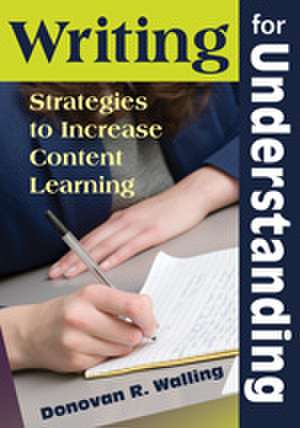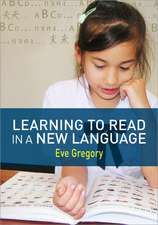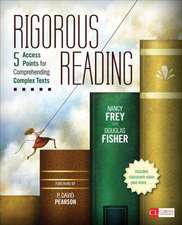Writing for Understanding: Strategies to Increase Content Learning
Editat de Donovan R. Wallingen Limba Engleză Paperback – 2 noi 2009
| Toate formatele și edițiile | Preț | Express |
|---|---|---|
| Paperback (1) | 226.05 lei 6-8 săpt. | |
| SAGE Publications – 2 noi 2009 | 226.05 lei 6-8 săpt. | |
| Hardback (1) | 450.03 lei 6-8 săpt. | |
| SAGE Publications – 2 noi 2009 | 450.03 lei 6-8 săpt. |
Preț: 226.05 lei
Nou
Puncte Express: 339
Preț estimativ în valută:
43.25€ • 45.07$ • 35.81£
43.25€ • 45.07$ • 35.81£
Carte tipărită la comandă
Livrare economică 03-17 aprilie
Preluare comenzi: 021 569.72.76
Specificații
ISBN-13: 9781412964357
ISBN-10: 1412964350
Pagini: 144
Ilustrații: illustrations
Dimensiuni: 178 x 254 x 9 mm
Greutate: 0.33 kg
Ediția:annotated edition.
Editura: SAGE Publications
Colecția Corwin
Locul publicării:Thousand Oaks, United States
ISBN-10: 1412964350
Pagini: 144
Ilustrații: illustrations
Dimensiuni: 178 x 254 x 9 mm
Greutate: 0.33 kg
Ediția:annotated edition.
Editura: SAGE Publications
Colecția Corwin
Locul publicării:Thousand Oaks, United States
Recenzii
"Because the writing process requires students to use and process content, it helps them understand what they are learning. Walling's book provides practical and powerful ways to use writing as a learning tool in a wide variety of subject areas."
"This carefully researched book guides teachers of all disciplines through the uses of narrative, description, exposition, persuasion, and argument in pursuit of student learning. Through ample illustrations of interactive classroom dialogues and sample writing assignments, Walling introduces readers to a wide variety of ways to use writing to support learning in classes that range from mathematics and science to art and physical education. Even though having students write as a way of learning is not about 'correctness,' Walling offers reassuring chapters on grammar and usage, and his annotated bibliography of resources from across the curriculum is not to be missed."
"Through student writing samples and classroom dialogues, Walling demonstrates how all content teachers can use various writing modes to enrich students' content knowledge to the level of innovation and greater clarity."
"Walling provides all classroom teachers with the tools to use writing as a catalyst to learning. All classroom teachers, including English teachers, will find this book useful because it not only discusses how to set up writing assignments, but also explains how writing complements learning."
"Walling has created an outstanding book that is easy to read and understand, with valuable tips that will make any teacher a more effective instructor. While we have all read of 'writing across the curriculum areas,' Walling gives us an understanding of what this really means and provides examples that any teacher can modify to expand lessons to a more meaningful level, thus enhancing both writing and critical thinking skills in students."
"This carefully researched book guides teachers of all disciplines through the uses of narrative, description, exposition, persuasion, and argument in pursuit of student learning. Through ample illustrations of interactive classroom dialogues and sample writing assignments, Walling introduces readers to a wide variety of ways to use writing to support learning in classes that range from mathematics and science to art and physical education. Even though having students write as a way of learning is not about 'correctness,' Walling offers reassuring chapters on grammar and usage, and his annotated bibliography of resources from across the curriculum is not to be missed."
"Through student writing samples and classroom dialogues, Walling demonstrates how all content teachers can use various writing modes to enrich students' content knowledge to the level of innovation and greater clarity."
"Walling provides all classroom teachers with the tools to use writing as a catalyst to learning. All classroom teachers, including English teachers, will find this book useful because it not only discusses how to set up writing assignments, but also explains how writing complements learning."
"Walling has created an outstanding book that is easy to read and understand, with valuable tips that will make any teacher a more effective instructor. While we have all read of 'writing across the curriculum areas,' Walling gives us an understanding of what this really means and provides examples that any teacher can modify to expand lessons to a more meaningful level, thus enhancing both writing and critical thinking skills in students."
Cuprins
Introduction: How Can I Teach Writing If I'm Not a Writing Teacher?
1. How Writing Increases Understanding
Debunking Myths and Misconceptions
Alternatives to Bloom
Five Research-Based "Truths" About Writing
Developing Effective Writing Questions and Prompts
Daily Writing
Some Thoughts on Taking Notes
2. Developing Narrative Writing Assignments
What Is Narrative Writing?
Types of Narrative Writing
Using Narrative Writing
Class Dialogue
Using Narrative Writing to Build Content Vocabulary
Sample Narrataive Writing Questions and Prompts
3. Developing Descriptive Writing Assignments
What Is Descriptive Writing?
Using Descriptive Writing
Sensory Details
Describing Processes
Class Dialogue
Translating Mathematics
Giving Directions
Sample Descriptive Writing Questions and Prompts
4. Developing Expository Writing Assignments
What Is Expository Writing?
Using Expository Writing
Class Dialogue
Writing Prompts That Require Cause-and-Effect Reasoning
Sample Expository Writing Questions and Prompts
5. Developing Persuasive Writing Assignments
What Is Persuasive Writing?
Using Persuasive Writing
Class Dialogue
Persuasion and the Basics of Logic
Sample Persuasive Writing Questions and Prompts
6. Developing Argumentative Writing Assignments
What Is Argumentative Writing?
Using Argumentative Writing
Class Dialogue
Follow-Up Sharing and Discussion
Sample Argumentative Writing Questions and Prompts
7. Using Dialogues About Writing to Build Meaning
A Basis in Socratic Questioning
Developing and Using Class Dialogues
Developing and Using Student Dialogues
Making and Using Rubrics
8. Internet-Writing Connections and Resources
Using E-Speak to Encourage Writing
Online Resources Can Help Students and Teachers
Websites for Students
Websites for Teachers
9. Frequently Asked Questions About Writing
Language Alive
Usage
Punctuation
10. Print Resources
Books
Documents
References
Index
1. How Writing Increases Understanding
Debunking Myths and Misconceptions
Alternatives to Bloom
Five Research-Based "Truths" About Writing
Developing Effective Writing Questions and Prompts
Daily Writing
Some Thoughts on Taking Notes
2. Developing Narrative Writing Assignments
What Is Narrative Writing?
Types of Narrative Writing
Using Narrative Writing
Class Dialogue
Using Narrative Writing to Build Content Vocabulary
Sample Narrataive Writing Questions and Prompts
3. Developing Descriptive Writing Assignments
What Is Descriptive Writing?
Using Descriptive Writing
Sensory Details
Describing Processes
Class Dialogue
Translating Mathematics
Giving Directions
Sample Descriptive Writing Questions and Prompts
4. Developing Expository Writing Assignments
What Is Expository Writing?
Using Expository Writing
Class Dialogue
Writing Prompts That Require Cause-and-Effect Reasoning
Sample Expository Writing Questions and Prompts
5. Developing Persuasive Writing Assignments
What Is Persuasive Writing?
Using Persuasive Writing
Class Dialogue
Persuasion and the Basics of Logic
Sample Persuasive Writing Questions and Prompts
6. Developing Argumentative Writing Assignments
What Is Argumentative Writing?
Using Argumentative Writing
Class Dialogue
Follow-Up Sharing and Discussion
Sample Argumentative Writing Questions and Prompts
7. Using Dialogues About Writing to Build Meaning
A Basis in Socratic Questioning
Developing and Using Class Dialogues
Developing and Using Student Dialogues
Making and Using Rubrics
8. Internet-Writing Connections and Resources
Using E-Speak to Encourage Writing
Online Resources Can Help Students and Teachers
Websites for Students
Websites for Teachers
9. Frequently Asked Questions About Writing
Language Alive
Usage
Punctuation
10. Print Resources
Books
Documents
References
Index
Descriere
Written specifically for non–language arts teachers, this resource focuses on using writing as an instructional tool to deepen and expand student understanding in the content areas.





